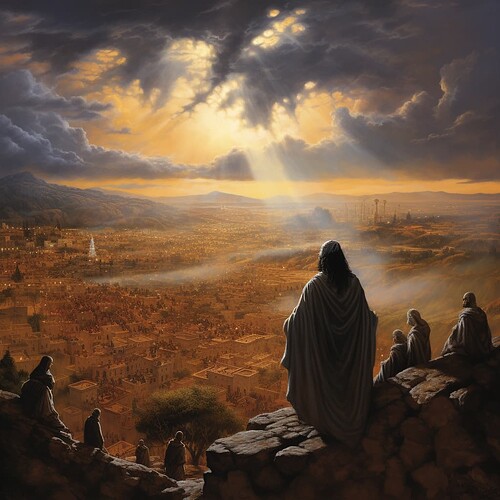![]() January 22: Matthew 24: Signs of the End Times and the Coming of the Son of Man
January 22: Matthew 24: Signs of the End Times and the Coming of the Son of Man
Deciphering Eschatological Prophecies and the Promise of Christ’s Return
 Introduction
Introduction
Today, we immerse ourselves in Matthew 24, a chapter rich in eschatological teaching. Here, Jesus discusses the signs of the end times and His eventual return, providing both warnings and hope.
 Matthew 24: The Olivet Discourse
Matthew 24: The Olivet Discourse
Jesus’ discourse on the Mount of Olives outlines the events leading to the end times, including false messiahs, wars, natural disasters, and persecution, culminating in His glorious return.
Key Verse: “Therefore keep watch, because you do not know on what day your Lord will come.” — Matthew 24:42
 Key Themes and Reflections:
Key Themes and Reflections:
Signs of the End Times: Jesus describes various signs and events, urging vigilance and discernment as the world moves towards its final destiny.
Perseverance in Faith: The chapter highlights the need for steadfastness in faith amidst trials, emphasizing that endurance leads to salvation.
The Certainty of Christ’s Return: Despite uncertainties about the timing, the promise of Christ’s return is a central tenet of Christian hope.
 Today’s Application:
Today’s Application:
Reflect on the transient nature of worldly events and the eternal significance of Christ’s teachings. Evaluate how prepared you are for Christ’s return and how you can live a life of readiness and faithfulness.
 Hidden Gem:
Hidden Gem:
Did you know? The illustration of the fig tree in Matthew 24:32–35 symbolizes the need to recognize the signs of the times and respond appropriately.
 Reflective Q&A:
Reflective Q&A:
![]() Matthew 24: Eschatological Teachings
Matthew 24: Eschatological Teachings
![]() Interpreting the Signs of the Times: How does Matthew 24 guide us in understanding and responding to current world events?
Interpreting the Signs of the Times: How does Matthew 24 guide us in understanding and responding to current world events?
A: This chapter encourages us to view world events through the lens of scripture, discerning the signs without fear, and focusing on living a life that honors God as we anticipate Christ’s return.
![]() Living in Expectation of Christ’s Return: How can we live in a state of readiness for Christ’s return?
Living in Expectation of Christ’s Return: How can we live in a state of readiness for Christ’s return?
A: Living in expectation involves cultivating a deep relationship with Christ, engaging in consistent prayer, and being active in faith and service. It’s about being spiritually vigilant and morally responsible.
 Join the Discussion:
Join the Discussion:
How does the promise of Christ’s return shape your worldview and daily life? Share how you stay spiritually alert and ready in the comments below!
#Matthew24 #EndTimes #SecondComing #Faith #Vigilance #BibleStudy #SpiritualJourney
![]() See You Tomorrow in Matthew: Journey with us as we continue to explore the teachings of Jesus in the Gospel of Matthew.
See You Tomorrow in Matthew: Journey with us as we continue to explore the teachings of Jesus in the Gospel of Matthew.
 Join the forum!
Join the forum!
Discover more and deepen your understanding in our AIgniteScripture Community:
Free Members: Join lively discussions and access various biblical resources. Sign up here: 🌟 How to Join Page - Membership Options
Supporters Membership ($20/month or $200/year): Access in-depth insights, newsletters, and special forum areas. Join as a Supporter: 🌟 How to Join Page - Membership Options
![]() Stay Updated with our AIgniteScripture Newsletter: Follow daily readings and insights. Subscribe now: https://newsletter.aignitescripture.com/
Stay Updated with our AIgniteScripture Newsletter: Follow daily readings and insights. Subscribe now: https://newsletter.aignitescripture.com/
